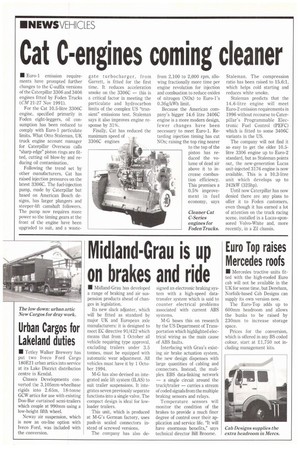Cat C-engines coming cleaner
Page 10

If you've noticed an error in this article please click here to report it so we can fix it.
• Euro-1 emission requirements have prompted further changes to the C-suffix versions of the Caterpillar 3306 and 3406 engines fitted by Foden Trucks (CM 21-27 Nov 1991).
For the Cat 10.5-litre 3306C engine, specified primarily in Foden eight-leggers, oil consumption has been reduced to comply with Euro-1 particulate limits. What Otto Staleman, UK truck engine account manager for Caterpillar Overseas calls "sharp edge" piston rings are fitted, cutting oil blow-by and reducing oil contamination.
Following the trend set by other manufacturers, Cat has raised injection pressures on the latest 3306C. The fuel-injection pump, made by Caterpillar but based on American Bosch designs, has larger plungers and steeper-lift camshaft followers. The pump now requires more power so the timing gears at the front of the engine have been upgraded to suit, and a waste gate turbocharger, from Garrett, is fitted for the first time. It reduces acceleration smoke on the 3306C — this is a critical factor in meeting the particulate and hydrocarbon limits of the complex US "transient" emissions test. Staleman says it also improves engine response by 31%.
Finally, Cat has reduced the maximum speed of 3306C engines from 2,100 to 2,000 rpm, allowing fractionally more time per engine revolution for injection and combustion to reduce oxides of nitrogen (N0x) to Euro-l's 0.36g/kWh limit.
Because the American company's bigger 14.6 litre 3406C engine is a more modern design, fewer changes have been necessary to meet Euro-1. Retarding injection timing has cut NOx; raising the top ring nearer to the top of the piston has reduced the volume of dead air above it to increase combustion efficiency. This promises a 0.5% improvement in fuel economy, says
Staleman. The compression ratio has been raised to 15.6:1, which helps cold starting and reduces white smoke.
Staleman predicts that the 14.6-litre engine will meet Euro-2 emission requirements in 1996 without recourse to Caterpillar's Programmable Electronic Fuel Control (PEFC) which is fitted to some 3406C variants in the US.
The company will not find it so easy to get the older 10.5litre 3306 engine up to Euro-2 standard, but as Staleman points out, the new-generation Lucas unit-injected 3176 engine is now available. This is a 10.3-litre unit which develops up to 242kW (325hp).
Until now Caterpillar has now denied there are any plans to offer it to Foden customers, even though it has earned a lot of attention on the truck racing scene, installed in a Lucas-sponsored Volvo-White and, more recently, in a Zil chassis.












































































